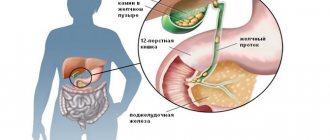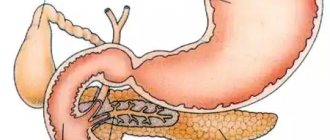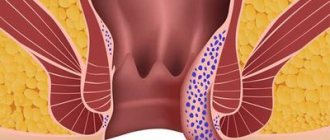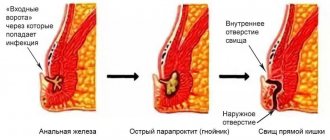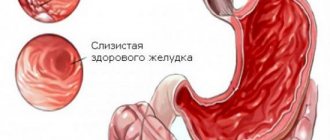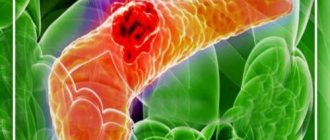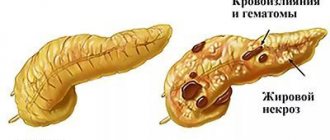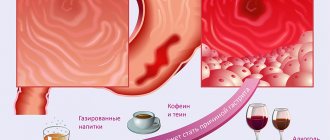Acute pancreatitis: symptoms, causes, complications
The main symptom of acute pancreatitis is severe aching pain in the upper abdomen that lasts for several days. Half the time it goes to the back. Often accompanied by nausea, vomiting, and fever.
The disease develops due to a malfunction of pancreatic enzymes: they do not enter the intestines and begin to digest the gland itself. In response to damage, an immune reaction is triggered, which leads to swelling and inflammation of the organ.
This process can lead to complications, including shock and multiple organ failure. Moreover, the risk of bacterial infection increases due to the disruption of the intestinal barrier.
The most common causes of acute pancreatitis are gallstones and alcohol abuse. They cause over 70% of all cases of the disease.
Relevance of the problem of the combined course of chronic pancreatitis and gastroesophageal reflux disease
Despite significant advances achieved in modern diagnostics and pharmacotherapy, the problem of concomitant diseases is one of the most difficult areas of therapy. One such example in clinical gastroenterology is the combination of gastroesophageal reflux disease (GERD) and chronic pancreatitis (CP), which contributes to the deterioration of the clinical course of the latter and often an increase in the number of complications. It is important to emphasize that against the background of exacerbation of pancreatic (P) pathology, the symptoms of GERD are often “ignored”, which certainly not only affects the quality of treatment for patients in this category, but also affects the socio-economic aspects of the problem of concomitant diseases. The problem of the combined course of these two pathologies is very relevant in terms of early disability, as well as a decrease in the working capacity of this category of patients. These facts are often due, along with the high prevalence of GERD, as well as CP in the Russian population, to the rather poor awareness of patients about the presence of the disease, sometimes inadequate prescription of drug therapy, its low effectiveness and polypharmacy.
Epidemiology of CP and GERD
According to epidemiological analysis, despite significant advances achieved in modern diagnostics and pharmacotherapy, CP retains a leading position in gastroenterology in terms of prevalence, increase in incidence, temporary disability and cause of disability. Thus, in the structure of pathology of the gastrointestinal tract, it occupies from 5.1 to 9.0%, and in general clinical practice – from 0.2 to 0.6% [1]. There is a worldwide trend toward an increase in the incidence of acute and CP, and in Russia the dramatic situation is due not only to the increase in the prevalence of CP among adults (27.4–50.0 cases per 100 thousand population), but also among adolescents and young adults [2]. It is also important to note the fact that the clinical and social significance of CP is manifested in its extremely negative impact on the quality of life of patients. The extremely high clinical significance of CP is inherently associated with the risk of complications, the mortality rate of which is up to 5.5% [1].
At the same time, the clinical and epidemiological structure of GERD over the past decades has acquired current, global significance, due not only to the expansion of complaints of an “extra-esophageal” nature, but also to the growth of complications such as Barrett’s esophagus and esophageal adenocarcinoma [3]. Thus, heartburn, which is the most common symptom of GERD, worsens the quality of life of 60% of European respondents [4], while the degree of reduction in quality of life is comparable to that in patients with coronary heart disease, arterial hypertension and peptic ulcer disease [5]. According to the results of Russian studies conducted in Novosibirsk, St. Petersburg and Krasnoyarsk, it was noted that about 60% of residents of Novosibirsk and approximately 46% of residents of St. Petersburg and Krasnoyarsk suffer from heartburn [4].
According to recent studies, the combined course of CP and GERD is quite common [6, 7].
Common pathogenetic mechanisms of CP and GERD
It is well known that GERD belongs to the group of acid-dependent diseases (ADDs), in the development and maintenance of which the acid-peptic factor plays a significant role. In addition, among the diseases of this group, peptic ulcer disease is the most common in the population; non-ulcer (functional) dyspepsia; gastropathy induced by non-steroidal anti-inflammatory drugs; Zollinger-Ellison syndrome.
The commonality of the pathogenetic mechanisms of the formation of acid-dependent forms of pathology of the digestive organs follows from the position put forward by the famous Austrian scientist K. Schwarz (1910), which states: “Without acid there is no ulcer,” which from the modern standpoint of the development of gastroenterology allows us to state: “Without acid there is not only ulcers, but also other KZZ.” In this regard, it can quite reasonably be classified as KZZ and CP. Back at the end of the 19th century. I.L. Dolinsky and L.D. Popelsky proved the close connection between pancreatic secretion and hydrochloric acid coming from the stomach into the duodenum (DU), which is a physiological stimulator of the secretory activity of the pancreas through the formation of hormonal substances such as secretin and cholecystokinin [8]. Thus, along with the leading role of the damaging effect of pancreatic enzymes themselves in the development of inflammatory-dystrophic changes in the pancreas, hypersecretion of hydrochloric acid is also of cardinal importance in the initiation of these pathological processes.
Clinical and diagnostic aspects of the combined course of CP and GERD
If we talk about the clinical manifestations of CP, then, as is known, the most painful for patients, which to the greatest extent determine the decrease in the quality of life of patients, are abdominal pain syndrome (APS) and exocrine pancreatic insufficiency syndrome. It is important to note that abdominal pain and exocrine pancreatic insufficiency, not only in clinical terms, but also in terms of frequency of occurrence, are the dominant symptoms of CP. The leading and most persistent in the onset of CP remains ALS, which can sometimes lead to malnutrition, cachexia, drug addiction, and in some cases to surgical interventions. Functional pancreatic insufficiency at the onset of the disease has minimal manifestations, and as the organ becomes fibrotic and acinar and islet cells atrophy, when at least 90% of the actively functioning pancreatic parenchyma is involved in the pathological process, the pain, as a rule, subsides, while pancreatic insufficiency progresses, which leads to the phenomena of maldigestion and malabsorption. At the same time, at this stage of the course of CP, an increase in pancreatic pain syndrome may be noted, caused by flatulence, which occurs both due to a decrease in the exocrine activity of the pancreas, and as a result of disturbances in motility and normal intestinal microflora [9].
It is important to note that the occurrence or intensification of flatulence in patients with a combined course of CP and GERD inevitably leads to aggravation of the course of the latter, provoking the appearance of severe heartburn, as well as feelings of discomfort, pain in the epigastrium and/or behind the sternum, in the area of the xiphoid process. It is impossible not to take into account the fact that in elderly patients (according to our observations) with a long history of CP and GERD, pain syndrome may not be observed at all, heartburn only occasionally occurs, while morphological changes in the pancreas and the mucous membrane of the esophagus can be pronounced. In addition, almost all patients, both with isolated variants and with the combined course of GERD and CP, experience disturbances in the evacuation function of the stomach, manifested by a feeling of rapid satiety, bloating, nausea, and vomiting.
Among the possible clinical and pathogenetic aspects of the formation of combined pathology within the framework of CP and GERD, including duodenostasis, impaired motility of the upper digestive tract, etc., the state of hyperacidity occupies a significant place. So, according to N.B. Gubergrits et al., in almost all patients suffering from CP, esophagitis of varying severity is detected [7].
Therapeutic approaches in conditions of combined CP and GERD
Taking into account the acid-dependent nature of these diseases, it seems quite logical to use drugs whose action is aimed at neutralizing or suppressing the production of hydrochloric acid by parietal cells. Today, among antisecretory drugs, proton pump inhibitors (PPIs), as the most powerful suppressors of gastric secretion, are, according to the Genval Agreement of 1997, the main means of treating GERD [9].
However, the treatment of CP with the manifestation of abdominal pain and exocrine pancreatic insufficiency is not an easy task, both due to objective difficulties associated with the multifactorial pathogenetic mechanisms of their formation, and due to the wide range of possibilities for choosing the optimal treatment regimen or the most effective drug.
The choice of therapy is determined based on the goals of treatment of CP, which are:
- ensuring functional rest of the pancreas;
- pain relief;
- restoration of exocrine organ insufficiency.
To relieve abdominal pain during exacerbation of CP, antispasmodics and analgesics are used, especially in cases of organ ischemia, perineural inflammation and fibrosis [10]. In addition, inhibitors of pancreatic secretion are used, such as analogs of somatostatin, enkephalins, and blockers of hydrochloric acid secretion [11]. At the same time, as is known, antisecretory drugs serve as an important component of complex therapy for patients with CP to ensure physiological rest of the organ [12]. However, another fact must be taken into account: inhibitors of hydrochloric acid secretion mainly block the humoral secretin-mediated path of pancreatic secretion, while vagal stimulation of enzyme production is largely preserved. Therefore, with the combined course of CP and GERD, it is also necessary to prescribe drugs that affect other pathogenetic components of CP.
The relevance of the problem of treatment of combined diseases is often due to the prescription of a mass of medications and, as a consequence, a high probability of developing side effects [13]. In this regard, one of the most important issues in the treatment of patients with a combination of CP and GERD is the problem of overcoming polypharmacy, which is especially relevant in the treatment of elderly people. In this case, it is necessary to take into account the fact of choosing drugs, taking into account not only clinical and pathogenetic, but also socio-economic factors. Therefore, we should talk about prescribing drugs with a cumulative clinical effect. An example of this approach in pancreatology is multienzyme therapy, which for many years has been prescribed only as a replacement therapy.
However, in recent years, special attention has been paid to the possibility of using enzyme preparations to relieve pain of pancreatic origin due to the mechanism of reverse inhibition of the production of pancreatic enzymes, the study of which began in 1970 [14].
It is known that the physiological regulation of the production of the pancreas’ own enzymes is carried out via a feedback mechanism [15]. When enzymes (in particular, proteases) enter the duodenal lumen, they interact with cholecystokinin (CCK)-releasing peptide. With a sufficient level of pancreatic enzymes in the duodenum, inactivation of the releasing peptide occurs, a decrease in the synthesis of CCK and, as a consequence, a decrease in the production of pancreatic enzymes. If there are not enough pancreatic enzymes in the duodenal lumen, then CCK-releasing peptide is not inactivated, an increase in CCK production occurs and, as a result, stimulation of the production of pancreatic enzymes. As a result, in the presence of CP, autolysis increases, intraductal pressure increases due to an increase in the volume of secretions, and pancreatic pain intensifies.
Thus, enzyme therapy not only replaces the deficiency of pancreatic enzymes in intestinal digestion, but also minimizes the secretory activity of the pancreas, promoting “functional” rest of the organ by inhibiting the production of pancreatic enzymes according to the feedback principle [16]. It is important to note that when antisecretory agents are added to treatment with enzyme preparations, there is an increase in the effectiveness of the latter in the treatment of CP [5].
The results of a number of foreign studies also showed a decrease in the severity of ALS when taking multienzyme drugs [17, 18]. This substantiates, in particular, the following point of view: tableted multienzyme preparations have certain advantages in relieving ALS, since the activation of the enzymes they contain begins directly in the proximal duodenum, which contributes to the rapid creation of functional rest of the pancreas and the subsidence of abdominal pain of pancreatic origin [19, 20]. In addition, it must be emphasized that the algorithm for the treatment of CP with pain, proposed in 1998 by the American Gastroenterological Association, directs the doctor to use tableted enzyme preparations [20].
The high clinical effectiveness of encapsulated enzyme preparations coated with an enteric coating and containing microspheres (microtablets, micropellets) in the correction of disorders of the exocrine function of the pancreas has been proven in numerous clinical studies that meet the principles of evidence-based medicine [21]. This form of the enzyme preparation has optimal passage through the digestive tract. The capsule quickly dissolves in the stomach, releasing microparticles (microgranules, minimicrospheres, micropellets), which, mixed with chyme, enter the duodenum and are activated in its distal sections, thus correcting the insufficiency of the exocrine function of the pancreas. Indications for the use of encapsulated enzyme preparations are steatorrhea, flatulence, and weight loss. It is important to note that if a patient has a combination of ALS and manifestations of exocrine insufficiency, the choice of an enzyme preparation is based on the high content of proteases and lipase, the presence of a protective acid-resistant membrane, the absence of bile acids in the composition of the drug (bile acids cause increased pancreatic secretion, as well as hologenic diarrhea) .
Thus, today multienzyme therapy is one of the leading areas of an integrated approach to the treatment of patients with CP. It should also be noted that, by minimizing and/or stopping the phenomena of maldigestion and malabsorption, multienzyme drugs indirectly affect the manifestations of flatulence, thereby reducing the clinical symptoms of GERD (frequent belching, a feeling of discomfort and heaviness in the epigastrium), which is especially important for patients with a combined course of CP and GERD. The use of multienzyme drugs significantly increases the clinical capabilities of relieving abdominal pain of pancreatic origin, as well as correcting exocrine insufficiency of the pancreas, while antisecretory therapy additionally ensures the creation of physiological rest of the pancreas, increases the effectiveness of multienzyme therapy, and also relieves the manifestations of GERD. Therefore, therapy for patients with a combined course of CP and GERD should be based on an integrated treatment approach, including multienzyme drugs, antisecretory agents, and, if necessary, antispasmodics and analgesics.
Chronic pancreatitis: symptoms, causes, complications
Pain in chronic pancreatitis differs from acute disease. It occurs sporadically, usually after eating. Over time, the pain becomes continuous. Symptoms of chronic pancreatitis also include bloating, weight loss, and fatigue.
The causes of chronic pancreatitis are not fully understood. It is known that fibrosis develops in the pancreas, that is, scars form. This is caused by repeated damage to the organ, including due to attacks of acute pancreatitis.
Possible complications of chronic pancreatitis include:
- indigestion and malnutrition
- chronic abdominal pain
- diabetes
- pancreas cancer
Most often, the development of chronic pancreatitis is associated with alcohol consumption, diabetes mellitus, smoking and hereditary causes.
How is the disease diagnosed?
The doctor may suspect an attack of pancreatitis based on the nature of the complaints and during the examination. Laboratory tests - clinical and biochemical blood tests - will help confirm the suspected diagnosis. In the acute stage, amylase and other enzymes increase several times. Increased liver transaminases may also indicate inflammation of the pancreas. And, of course, the doctor sends the patient for an ultrasound, which can detect swelling and other changes in the pancreas, and, together with the test results, quickly make a diagnosis.
As part of prevention, it is advisable to conduct an ultrasound of the abdominal organs 1-2 times a year, monitor the coprogram and indicators of amylase, lipase, sugar, cholesterol, triglycerides in the blood serum and elastase in the feces.
Acute and chronic pancreatitis: treatment
Pancreatitis can only be treated by a doctor. It includes:
- anesthesia
- restoration of pancreas function
- prevention and treatment of complications
For acute pancreatitis, supportive treatment is prescribed: a drip with an isotonic solution, intravenous nutrition and painkillers. If complications and concomitant diseases are observed, the doctor may prescribe antibiotics and additional treatment, including intensive care.
Treatment of chronic pancreatitis can be surgical. Depending on the area of the lesion, doctors remove part of the organ or connect it to the jejunum if there is obstruction of the pancreatic ducts. The operation helps relieve pain in 70-80% of patients.
Main symptoms of pancreatitis
The first signs are pain, nausea, vomiting, fever. In acute cases, pain is concentrated in the epigastric region and radiates to the left hypochondrium. In the chronic form of the disease, the pain is dull and can be felt in different places - in the left, right hypochondrium, epigastrium, radiate to the lower back, taking on a girdling character, depending on which part of the pancreas the inflammation occurred in. The pain can even radiate to the heart and left arm, reminiscent of the symptoms of a heart attack. In an acute attack of pancreatitis, the pain is very severe, in a chronic attack it is less pronounced. In the acute stage of the disease, the temperature reaches very high levels, in the chronic stage it rises moderately or may be normal.
Signs of acute pancreatitis
Acute pancreatitis is recurrent - the attack can recur within the first six months. If this happens after a longer period of time, it means that the disease has become chronic and now the person is forced to put up with certain restrictions throughout his life.
Where is pancreatitis treated? Treatment of pancreatitis in European clinics
Often pancreatitis becomes a concomitant disease against the background of gallstone disease, cardiovascular disorders, and oncology. The success of treatment depends on correct diagnosis: pancreatitis can be mistaken for a heart attack, ulcer, appendicitis and other conditions.
Foreign clinics have more diagnostic capabilities: advanced imaging and laboratory technologies are used. This allows you to avoid mistakes in diagnosis and prescribe the right treatment to patients.
Thus, patients with pancreatitis undergo CT, angiography, laparoscopy, and endoscopic examination. All this is necessary to exclude other diagnoses and assess the severity of the disease.
Doctors take care to prescribe sufficient doses of pain relief. During surgical interventions, minimally invasive procedures are performed: after technically complex operations, there are practically no scars left on the body. The patient's recovery is rapid.
In addition, in European clinics it is customary to take care of the patient, surrounding him with physical and psychological comfort. Foreign patients can be accommodated in the same room with a close relative.
Organization of treatment of pancreatitis in foreign clinics
Modern medicine can improve the patient’s condition with pancreatitis and prevent complications of the disease. If you want to find out about the possibilities of treating your disease abroad, contact us by phone (toll-free line) or leave a request on the website. The initial consultation with a doctor and analysis of medical documents are carried out free of charge and in compliance with medical confidentiality.
“Treatment Abroad” has been organizing trips for diagnostics and treatment abroad since 2003. We can organize a trip even during a lockdown due to a pandemic. Our doctors know foreign languages and are constantly in contact with foreign clinics. We focus on available treatment methods and select the most suitable options for each client.

